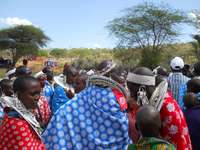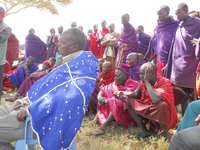Pastoralism has been for centuries an important component of living for multiple tribal groups in Africa, particularly for the Maasai. Historically tied to a nomadic life, pastoralism is changing. It is also in jeopardy, both as a cultural practice and as a way of sustaining a livelihood. This is especially true in Tanzania. Some form of agricultural production involves about 90 percent of its population. Contrary to popular belief, pastoralists are an important component of that production.
A Classic Case of Misunderstandings and Need for Change

Figure 1. Masai community gathering. Source: Eamonn Brehony
The issues surrounding current pastoralist practices are very complex. A recent symposium sponsored by ECHO East Africa focused attention on some crucial issues. It also addressed several potential remedies for the conflicts and challenges facing the Maasai and pastoralism in general.
Two resource leaders of a recent ECHO Symposium on Pastoralism, Eamonn Brehony and Alais Morindat have a combined 65 years of experience and study of pastoralism. They see pastoralism as not only important to the Maasai, but to the future viability of the nation-state.
Brehony holds a Ph. D. in Rural Development. He has advised pastoralist organizations on issues related to strategy, policy engagement, and conflict management. He has also been directly involved in the management of some pastoral-related conflicts.
Morindat is with the International Institute for Environment and Development. He is a Maasai with authority and advocates for securing pastoralist access to land and resources. His years of research and analysis have focused on the development of effective policies and governance by numerous agencies in Tanzania and in the Eastern Africa region.
Brehony and Morindat shared important insights into Pastoralism, summarized below.
A Review of Pastoralism: Its Components
Pastoralism, meaning the movement of people with their livestock over rangelands remains prevalent in Tanzania. A pastoralist lives off his animals.
For the Maasai, the primary practice, historically, has been to roam vast savanna rangelands. The movement is dependent on rainfall and available grassland. His livestock plays an essential role in his family’s nutrition and also his esteem within the community. The pastoralist will sell his animals in traditional markets to generate income.
The Issue
In today’s Tanzanian society, pastoralism has become a major source of conflict and distrust. The issues include dwindling access to rangeland; land usage; maintenance of long-term sustainability of the land, pastures, forests, and wildlife; severe malnutrition; and education of all.
This symposium revealed the serious lack of acknowledgment and appreciation for the practice of pastoralism as a central part of tribal culture. The Maasai see current government policy and practice as an attack on their way of life.
Brehony observed:
pastoralism for the Maasai has always put them on the edges of the larger society, on the edges of villages and vast plains, …very removed from the farming community and other peoples…it is a way of life that has put them on the margins.
Morindat agrees, but confirms that this is a purposeful choice of pastoralists themselves: “they have decided which way of life is most useful for them”.

Figure 2. Pasture and herd in dry season. Source: Eamonn Brehony
There are three important components to successful pastoralism. First, are the natural resources including pasture, water, forest, and salt. The livestock is of central importance as they provide food, milk, blood, and livelihood through the selling of animals. Finally, the pastoralist needs to coordinate and bring together all these factors.
One of the ongoing problems is a perception that the Maasai are using tracts of land that interfere with other livelihoods. Now, much of that rangeland is farmed or has been taken over by the government. “My analysis,” Morindat stated, “is that most of the land utilized by the pastoralists is not suitable for traditional farming”.
There have been conflicts, well documented, that extend beyond the agricultural use of land. These conflicts often center on the use of other natural resources. For example, conflicts have recently surfaced over mining in some areas.
The leaders also cited issues surrounding mobility. It is a critical and central practice of the pastoralist.
Mobility practices have been, historically, organized by traditional leaders and systems. It is highly dependent on rainfall and thus sufficient pasture. The movement of the pastoralist and his herd have been a central factor in preserving grazing lands and preventing ecological damage. However, changing policies and government regulations have greatly lessened mobility.
Pastoralists now find themselves in great difficulty accessing grazing land because of changing policies. They also feel land was given to them by God and the nation-state is being taken away.
Collaboration and Organization A Must
Unity of voice for pastoralists must be addressed. Many factors make unity a major challenge. Probably the greatest challenge is simply their traditional way of life. Rules and regulations of the nation-state impinge on their life.
Pastoralists must become organized and speak in unity to affect policies that influence their livelihood. The positives of pastoralism need to be highlighted and communicated to the government. This is important for both the tribes and the larger society.
Brehony states:
Today many in our country see pastoralism as a finished business - - it is a way of life whose time has passed. (Many feel) it is a waste of time to embrace their way of life. They fail to see it as a very clever way of life.

Figure 3. Masai community gathering. Source: Eamonn Brehony
Pastoralism provides livelihood on marginal lands. The Maasai add a very unique and colorful dimension to the life of Tanzania. It draws tourism. It adds significantly to the total blend and attractiveness of the culture.
Pastoralists make a significant contribution to the economy. Their livestock provides much-needed food, a significant amount, to society. This whole process also employs many people. Again, these facts need to be communicated in an organized way to the country’s leadership.
Brehony suggests that more alliances are needed across the economy, not just for Pastoralists. “I’d love to see, for example, alliances form among small farmers and small fishermen: they face the same challenges as the pastoralists.”
Policy Development
Despite the challenges, some signs point to a more positive outlook on pastoralism as a way of life.
In the past 20-plus year many organizations have studied and advocated for pastoralists. The government itself has shown more recognition of its role. Some government officials are cognizant of the contribution of pastoralists and have spoken in favor of their way of life. Some NGOs have helped pastoralists develop coping strategies. Brehony and Morindat see opportunities for the Maasai in the Land Act which allows the ability to get rights of occupancy. There are also other favorable legislative provisions to follow up in practice.
Policies on the reduction of poverty are also needed, particularly those policies that directly impact tribal life.
Education
Part of the success of self-advocacy involves education. This becomes apparent on many fronts.
Education is required to effectively understand and affect government and international policy. The Maasai must form institutional alliances, maintain communication among groups, and become in more control of their destiny. All of these outcomes, and more, mandate education.
Ironically, however, the education today of young people has often steered them away from pastoralism and led them to more urban life. Education of youth, where present, has also caused some disarray among traditional leadership. What is needed is a recognition in the larger society that pastoralism is essential for the nation-state. Young educated leadership interested in pastoralism must be affirmed and supported in ways that affirm their importance to both tribal life and society. The younger generation must see they have an important role in achieving this goal.
Needed Reform of Some Practices
Land use planning is essential as we move forward. While this involves the State, the Pastoralists must have input.
This planning must also involve the Maasai directly in assuring good use of the ecological aspects of all the land. Climate change, and the resulting changes in dryness and rainfall, must be part of their awareness.
Women, and their role, are essential in this future. They must be empowered to be a part of the dialogue and decisions.
In Conclusion
There is not one simple solution to the challenges facing pastoralism and pastoralists. Brehony and Morindat have great hope for both the pastoralist and the nation-state if we address the knowledge gap on both sides, create dialogue, and move forward in solving the issues outlined.
Brehony states: “We have the opportunity to think critically and put on the table strategies that will liberate Pastoralists…and the poor of our country”. To which Morindat adds, “We need to look into the future with hope, enthusiasm, dedication, and commitment…not wasting time in bringing about this radical transformation.”